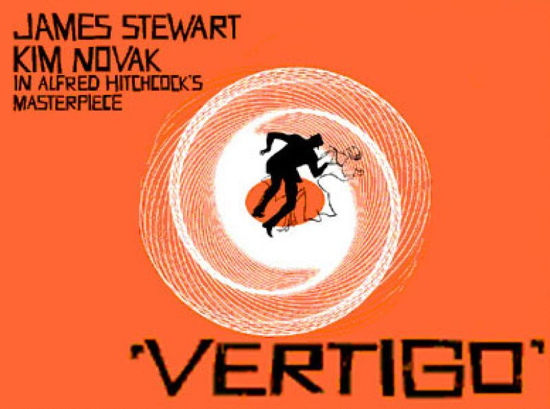It was a cool April morning in San Francisco. Just after 6am I stood in Claude Lane, between Bush and Sutter Streets. It’s the alleyway in which Madeleine parks her green Jaguar and disappears through a doorway, the rear entrance to the flower shop Podesta Baldocchi. Scottie follows Madeleine through the door, goes through a seedy back room, opens another door and peers through. He then stands behind a mirror and watches Madeleine, framed by flowers, posed and dreamlike.
My husband and I had come to San Francisco to visit each of the locations from Vertigo: a film about time and memory that we knew so well it had become part of our own internal landscapes. We wanted to walk in the footsteps of Madeleine and Scottie, not just observe the image but be inside it.
Much has been made of the fact that Vertigo is essentially a film about cinema, about the memorialisation of the past, about the creation of an object that the viewer is captivated by. The filmmaker brings an illusion to being, just as Gavin Elster does with Madeleine, and as Scottie, like a failed filmmaker, attempts to do with Judy.
But what is it about Vertigo that inspires such obsession? We weren’t the first to go, to follow in Hitchcock’s footsteps. The most notable pilgrimage was made by Chris Marker, who rented Scottie’s apartment on Lombard Street and included an unforgettable section about Vertigo in his 1983 masterpiece Sans Soleil. Even more strange than the fans who traverse the San Francisco of Vertigo is the fact that Kim Novak, the actress who played Madeleine, returns to the locations herself wearing a disguise.
The first thing to say is that the San Francisco of Vertigo is not the San Francisco that exists today. This may seem obvious, but that San Francisco didn’t even exist when Hitchcock was making the film. We stood in Claude Lane as the city was waking up, our breath held, taking the same path as Scottie. There is an odd feeling of having entered a memory, pausing in déjà vu, captured in a fold of time. Then my husband stepped backwards, tripped and stumbled over one of the city’s many homeless people. We were torn from the moment and revealed to be what we were: ridiculous tourists taking photographs of a random doorway in an alley.
Claude Lane

That doorway never led to Podesta Baldocchi, the flower shop where Madeleine buys the bouquet that matches the ones in the portrait of Carlotta Valdes. The fictive landscape was created by Hitchcock and imprinted on the actual San Francisco, so that the two overlap and give you a vertiginous feeling of the memory of having visited somewhere before, but it’s a somewhere that never really existed. In fact, while Chris Marker may have visited it, Podesta Baldocchi no longer exists, not in the same form. Hours spent walking across San Francisco for an address we found on the internet led to a flower warehouse that has the name Podesta Baldocchi, but nothing else, not even the bouquet carried by Madeleine.
But other places remain, actual points on a fictive landscape. The obvious ones are Coit Tower, the city’s almost vertical streets, and the Golden Gate Bridge. These are the landmarks that punctuate other San Francisco movies, such as Dirty Harry and The Conversation. Others have to be hunted for: Scottie’s apartment on Lombard Street; the Brocklebank Apartments that are home to Gavin Elster and where Scottie starts to follow Madeleine; Fort Point where Madeleine throws herself into the bay; the Mission Dolores with its dreamlike graveyard; the Palace of the Legion of Honor where Scottie finds Madeleine looking at the picture of Carlotta Valdes; and the Empire Hotel, where we were able to stay a night and which has since become the Hotel Vertigo, a memorial itself to the movie. These places aren’t quite as Hitchcock portrayed them. Everything is slightly off to the side – the red door on Scottie’s apartment is now white, there is no portrait of Carlotta at the Palace of the Legion of Honor.
Palace of the Legion of Honor
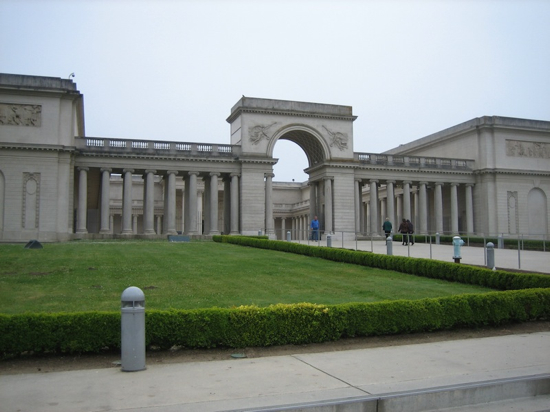
One of the most uncanny places to visit is the Mission San Juan Bautista, some 90 miles south of San Francisco. It remains in almost exactly the same condition as when Hitchcock filmed there. Everything down to the carriage that Madeleine sits in and the white plastic horse with its black-rimmed eye doubling the eye of Madeleine.
It’s even possible to visit the places that Scottie talks about but that never appear in the film, the old saloon and houses with their low ceilings. The whole place is a memorial to a time before Vertigo, and remains so. Walking across the grass towards the doorway where Scottie chases Madeleine, and then drags Judy, there is an echo of the past. You feel that you are repeating, in a faded and different way, something that you have done before.
Mission San Juan Bautista
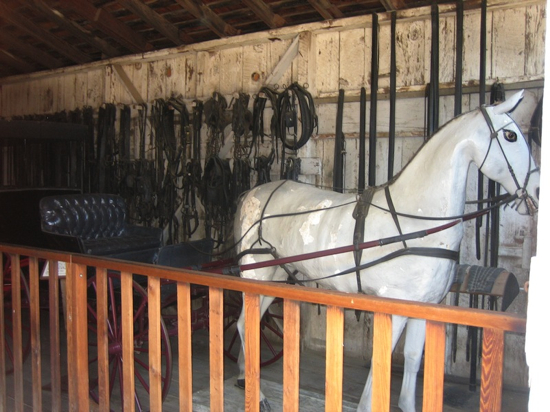
The tower, famously, does not exist, but was created by Hitchcock as a site for Scottie’s most traumatic attack of vertigo. It’s strange that the site of this spatial vertigo is a fiction, but it’s also a reminder that Vertigo isn’t simply a film about the vertigo of space, but is about the vertigo of time. It is about memories that haunt, figures that double and repeat themselves, poisons that erupt from the past to shatter illusions.
The vertigo of time is at the heart of the film, but what about the vertigo of meaning? That vertiginous feeling when you can’t distinguish truth from illusion. This, for me, is what warrants Vertigo‘s title of the greatest film of all time. It’s not that it has a meaning that is elusive or difficult to figure out, but that it overflows with possible sense.
Fort Point
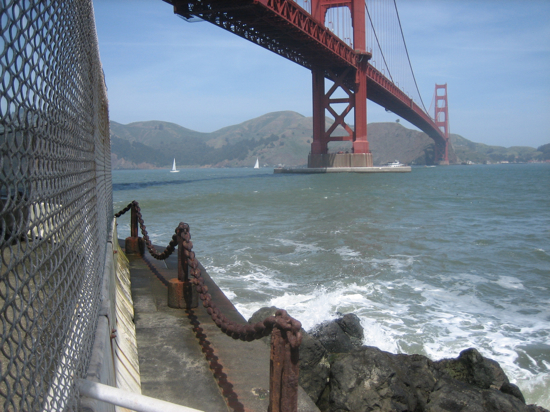
Every viewing of Vertigo elicits a new meaning, so that the filmic object produces difference without itself ever changing. It is a film that can be watched again and again and again, always with a slightly different eye.
On first viewing we sympathise with the tragic Madeleine who is going mad, haunted by her ancestor. She is tailed by Scottie, the hunter, a voyeur who shadows her movements. On second watching we know that Madeleine isn’t who she appears to be. It is Scottie who is hunted, seduced by this beautiful object that poses in flower shops and jumps into San Francisco Bay. Or third, she is a narcissistic criminal who never loved Scottie but only herself as Madeleine; Judy a common shop girl who was transformed by Elster into the poised and radiant Madeleine, and who lets herself be made over by Scottie so that she can be Madeleine again.
Fourth, with Chris Marker. This time Madeleine is truly Madeleine, troubled and haunted. Scottie is "time’s fool of love". He wanders through his memory, creating a new Madeleine – a tarnished Madeleine – who he can recreate as he remembers her, only to lose her again. Fifth, that through creating Madeleine it is Elster that seduced Scottie, emasculating the boorish detective. In the second half of the film, Scottie creates a psychological repetition of events in which he takes control of Madeleine, thus taking control of himself.
Brocklebank Apartments
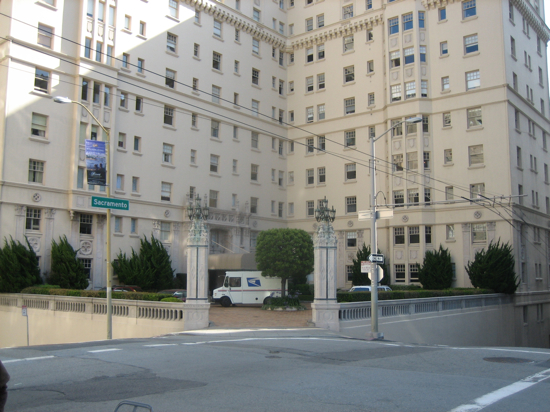
The street sign that says ‘One Way’, placed outside of the Brocklebank Apartments; the disappearance of Midge from the second half of the movie; the white horse’s eye; the red room at Ernie’s, which could be a cypher for the unconscious but was an actual place – one of Hitchcock’s favourite places – though it doesn’t exist any more. Vertigo is all these things, each at the same time. It is the cinematic equivalent of a Rubin’s vase. A shift of perspective and the picture is something different, but it never persists more as one or the other. Look at it this way, look at it that way, look at it another way. Each one is a hundred percent clear, but no interpretation is able to demolish the others. It’s possible to view the film from any perspective and it makes sense.
It is this vertigo of meaning that draws people obsessively to the movie’s locations. Like the stereotypical detective who is haunted by the one crime he couldn’t solve, so we are haunted by a multiplicity of possible meanings. But we can go there, walk the streets that they walked, follow directions to places that don’t exist, be within the echo of a shared memory. Being in San Francisco, standing in an alleyway or outside of an apartment, doesn’t give one a definitive meaning, but it brings an uncanny and visceral feeling of the vertiginous quality of time, and a sense of getting closer to the object of desire only to realise that how it appeared to be isn’t how it is in reality. The raw experience of meaning and truth and desire and time and memory – all in one specific place – will always engender a feeling of vertigo.
Vertigo screens throughout September at BFI Southbank as part of the venue’s ongoing Genius Of Hitchcock season. You can see more of Darren Ambrose’s photographs here.

